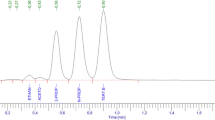Summary
Postmortem drug redistribution in suicidal poisonings by co-proxamol (dextropropoxyphene and paracetamol) has been studied. Analytical data for 8 tissue samples, including muscle and fat, up to 8 blood samples, and gastric and small bowel contents were obtained in 4 cases. Blood samples were taken from multiple sites at the start of autopsy and after 24 or 48 h. Concentrations of both drugs were site dependent with the lowest concentrations in peripheral blood. Paracetamol concentrations varied two to threefold and propoxyphene concentrations varied seven to tenfold. Pulmonary artery concentrations of paracetamol did not change significantly with time; propoxyphene concentrations typically increased twofold over 24 h and threefold over 48 h. Propoxyphene concentrations in the inferior vena cava increased unpredictably but occasionally significantly (up to sevenfold). For both drugs the most dramatic elevations of blood concentrations were seen in the aorta; in one case paracetamol rose to 1.9 g/l, 8 times the peripheral blood concentration and 4 times the liver level (454 mg/kg); propoxyphene rose to 191.5 mg/l, 55 times the peripheral blood concentration. This appears to reflect postmortem diffusion of unabsorbed drug from the gastric lumen. It is likely that markedly higher concentrations in the putrefactive fluid from the left pleural cavity as compared with the right also reflect diffusion from the stomach.
Zusammenfassung
Die postmortale Wirkstoffumverteilung bei suizidalen Vergiftungen mit Coproxamol (Dextropropoxyphen und Paracetamol) wurde untersucht. Die analytischen Daten von 8 Gewebsproben, incl. Muskeln und Fettgewebe, von bis zu 8 Blutproben und des Magen- und Dünndarminhalts lagen in 4 Fällen vor. Die Blutproben wurden von verschiedenen Orten zu Beginn der Obduktion entnommen und nach 24 oder nach 48 Stunden. Die Konzentrationen beider Wirkstoffe waren abhängig vom Entnahmeort, wobei sich die niedrigsten Konzentrationen im peripheren Blut fanden. Die Paracetamolkonzentrationen variierten um den Faktor 2–3 und die Propoxyphenkonzentrationen um das Siebenbis Zehnfache. Die Paracetamolkonzentrationen im Pulmonalarterienblut veränderten sich nicht signifikant über der Zeit; die Propoxyphenkonzentrationen verdoppelten sich typischerweise innerhalb von 24 Stunden und verdreifachten sich über 48 Stunden. Die Propoxyphenkonzentrationen in der Vena cava inferior zeigten unregelmäßige Anstiege, jedoch z.T. signifikante (bis zu siebenfach). Für beide Substanzen waren die stärksten Zunahmen der Blutkonzentrationen in der Aorta zu beobachten; in einem Fall stieg das Paracetamol auf 1,9 g/l an, somit um ein Achtfaches der peripheren Blutkonzentration und ein Vierfaches der Leberkonzentration (454 mg/kg); das Propoxyphen stieg auf 191,5 mg/l, somit auf ein 55faches der Konzentration im peripheren Blut. Die Ursache scheint eine postmortale Diffusion der noch nicht resorbierten Wirkstoffe aus dem Mageninhalt zu sein. Es ist wahrscheinlich, daß deutlich höhere Konzentrationen in der Fäulnisflüssigkeit der linken Pleurahöhle im Vergleich zur rechten ebenfalls aufgrund eines Diffusionsprozesses aus dem Magen zu erklären sind.
Similar content being viewed by others
References
Pounder DJ, Jones GR (1990) Post-mortem drug redistribution - a toxicological nightmare. Forensic Sci Int 45:253–263
Jones GR, Pounder DJ (1987) Site dependence of drug concentrations in postmortem blood - a case study. J Anal Toxicol 11:186–190
Prouty RW, Anderson WH (1990) The forensic science implications of site and temporal influences on postmortem blooddrug concentrations. J Forensic Sci 35:243–270
Constantino A, Caplan Y, Mergner W, Resau J (1991) Postmortem redistribution of amitriptyline: In vitro cellular factors and an in vivo rabbit model. Abstract. 43rd Annual Meeting of the American Academy of Forensic Sciences, Annaheim, California. 18–23 February 1991
Baselt RC, Cravey RH (1989) Disposition of toxic drugs and chemicals in man. Year Book Medical Publishers, Chicago, pp 723–728
Reynolds JEF (1989) Martindale. The extra pharmacopoeia. The Pharmaceutical Press, London, pp 1300–1301
Carson DJL, Carson ED (1977) Fatal dextropropoxyphene poisoning in Northern Ireland, review of 30 cases. Lancet I: 894–897
Ellenhorn MJ, Barceloux DG (1988) Medical toxicology, diagnosis and treatment of human poisoning. Elsevier, NewYork, pp 726–729
Ellenhorn MJ, Barceloux DG (1988) Medical toxicology, diagnosis and treatment of human poisoning. Elsevier, NewYork, pp 104–130
Okine LKN, Gram TE (1982) Drug absorption and distribution. In: Craig CR, Stitzel RE (eds) Modern pharmacology. Little, Brown and Company, Boston, pp 21–40
Garriott JC (1991) Skeletal muscle as an alternative specimen for alcohol and drug analysis. J Forensic Sci 36:60–69
Lokan RJ, James RA (1990) The use of putrefactive pleural effusions for drug estimation (abstract). Presented at International Association of Forensic Science Conference, Adelaide, Australia, October 1990
Fallani M (1961) Contributo allo studio della circolazione ematica post-mortale. Minerva Medicolegale 81:108–114
Author information
Authors and Affiliations
Rights and permissions
About this article
Cite this article
Yonemitsu, K., Pounder, D.J. Postmortem toxico-kinetics of co-proxamol. Int J Leg Med 104, 347–353 (1992). https://doi.org/10.1007/BF01369555
Received:
Issue Date:
DOI: https://doi.org/10.1007/BF01369555




